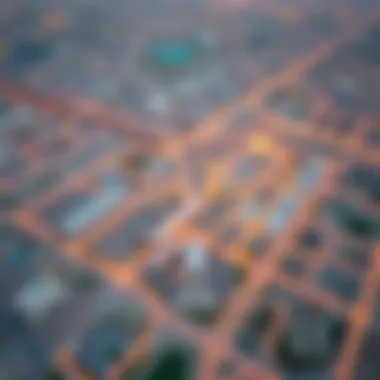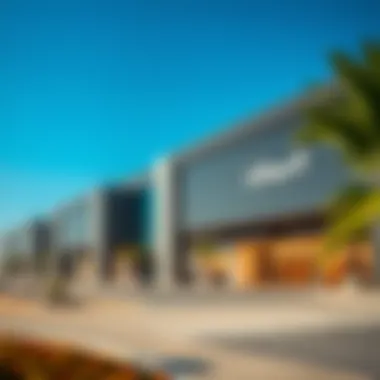Exploring the Mafraq Industrial Area's Economic Significance


Intro
The Mazraq Industrial Area stands as a critical pillar in the regional economy, playing a pivotal role in driving growth, fostering innovation, and creating ample opportunities for both businesses and investors. Understanding this hub requires more than just a surface-level glance; it's a quest into the very fabric of its operations, infrastructure, and potential. Here, we delve into its market trends, investment opportunities, and myriad characteristics that converge to shape its identity in the commercial landscape.
Market Trends and Insights
Current Market Conditions
Right now, the Mafraq Industrial Area is buzzing with activity. As a zone recognized for its manufacturing and logistics capabilities, it's currently experiencing a surge in demand for industrial real estate. The factors fueling this boom range from an influx of local entrepreneurial initiatives to the broader economic policies of the region that are favorably inclined towards industrial development.
From textile factories to electronics assembly plants, the variety of industries setting up shop here showcases the area's adaptive nature. This variety means that real estate agents are hard-pressed to keep up with demand. Prospective buyers and renters are also finding a motivation to act fast, lest they lose out on promising locations.
Future Predictions
Looking ahead, several trends are set to shape the Mafraq Industrial Area. Analysts anticipate a continuous influx of foreign investments as global corporations look to establish a foothold in Middle Eastern markets. Furthermore, sustainability and green technologies are gaining momentum, indicating a shift in how new projects will be evaluated and executed.
- Green Initiatives: There’s a growing consensus that businesses here will increasingly be judged on their environmental impact. Expect to see companies focusing on reducing their carbon footprints and implementing sustainable practices.
- Technological Integration: Automation and smart technologies are likely to redefine productivity in this sector. As industries incorporate more high-tech solutions, the need for skilled workforce training will grow simultaneously.
"The Mafraq Industrial Area is positioned not just for immediate growth but for sustainable long-term development that aligns with regional aspirations."
Investment Opportunities
Locations to Consider
Specific locales within the Mafraq Industrial Area stand out for their growth potential:
- Northern District: Renowned for its strategic transport links, it’s becoming the go-to location for logistics and warehousing.
- Southern Segment: Famous for attracting manufacturing businesses, this area offers close proximity to major highways.
Types of Properties Available
As the market heats up, a variety of property types are available for those interested in investing:
- Warehouses: Increasingly sought after due to the logistics boom.
- Manufacturing Units: Customizable spaces designed to accommodate specific industrial needs.
- Office Spaces: Ideal for companies looking to establish a regional headquarters, blending traditional office setups with industrial functionalities.
Overall, the Mafraq Industrial Area holds a central place in the narrative of the region's industrial growth, embodying the spirit of enterprise and innovation.
Prologue to the Mafraq Industrial Area
The significance of the Mafraq Industrial Area transcends mere geography; it weaves a narrative of economic potential and infrastructural development that is hard to ignore. Situated strategically in Jordan, Mafraq stands as a testament to how industrial zones can catalyze regional growth and transform local economies. With an ever-changing global market, the industrial area is pivotal not just for local businesses but for investors seeking fertile ground in strategic commerce.
Overview of the Region
The Mafraq Industrial Area sprawls across a landscape that features both natural and developed resources. Located northeast of Amman, it's been a significant junction that connects various trade routes and arterial roads. This region is not just defined by industrial buildings; its proximity to major highways, such as the Desert Highway, gives it an edge numerous other industrial hubs might lack.
Additionally, the local climate, while arid, influences operational costs related to utilities like water and electricity. Despite initial challenges posed by its geographical setting, ongoing infrastructural improvements have turned these hurdles into stepping stones for businesses looking to establish a foothold in the region.
Key Characteristics:
- Geographical Advantage: Proximity to important transport links.
- Economic Ecosystem: A mix of manufacturing, warehousing, and logistics.
- Cultural Heritage: Historical sites contribute to a rich local culture that attracts visitors.
This combination of characteristics blends together to create unique business opportunities that cater to various sectors, from manufacturing to services. Investors are increasingly setting their sights on the Mafraq Industrial Area, recognizing that it holds the promise of both profitability and sustainability.
Historical Context
The history of the Mafraq Industrial Area is closely tied to the economic evolution of Jordan, especially during the 20th century. When the Jordanian government initiated its focus on industrialization as a key strategy for economic growth, Mafraq was identified as an ideal location due to its strategic positioning and expansive land availability.
In the early years, the area was primarily agricultural, but as the economy shifted focus towards industrial activities, more policies and funding were directed to develop the infrastructure necessary to support such a transition. The government’s establishment of free zones and incentives for foreign investment paved the way for manufacturing firms looking to take advantage of the skilled labor force and logistical benefits.
Over the years, several multinational firms have set up operations in this region, which has opened up job opportunities for locals and contributed significantly to GDP. Yet, this development came with its challenges. The evolving landscape meant that environmental and regulatory considerations also had to be navigated.


"Understanding the historical context of the Mafraq Industrial Area is crucial for any investor or developer aiming to engage with its dynamic atmosphere. Acknowledge the past to better appreciate the future potential this area holds."
Today, as we stand at the crossroads of innovation and tradition, the Mafraq Industrial Area continues to evolve, embodying both the challenges of past growth and the opportunities of future advancements.
Strategic Importance
The strategic importance of the Mafraq Industrial Area cannot be overstated. This region serves as a linchpin in the economic framework of not just its immediate surroundings, but also the broad spectrum of industries that feed into it. The unique positioning of Mafraq acts as a funnel, pulling together various economic activities under one umbrella, which fosters better cooperation between businesses and government bodies. Enhancing this dynamism is paramount for the area's sustained growth.
1. Economic Impact on the Region
The economic impact of the Mafraq Industrial Area extends far beyond its borders. It catalyzes the local economy by generating employment opportunities, boosting investment inflow, and advancing infrastructure development. Numerous factories and facilities have sprouted, providing jobs for many, which carries a ripple effect into the local community. According to various estimates, thousands of jobs have been created, directly contributing to local livelihoods.
Moreover, the introduction of industrial activities has raised local businesses’ profiles. Small and medium-sized enterprises flourish through supply chains created to service larger sectors in the industrial area. The resulting economic diversification strengthens the overall resilience of the region. The positive effects reach sectors like retail, hospitality, and housing, ultimately elevating the living standards.
2. Logistical Advantages
The Mafraq Industrial Area is strategically located, lending itself to substantial logistical advantages. Accessibility is one of its paramount features; it connects major highways and transport routes, facilitating smooth transit of goods and services. The ability for businesses to transport raw materials in and products out efficiently cuts down on time and costs—key components in any successful endeavor.
"Efficiency in logistics is not just a byproduct, but a critical ingredient in the recipe for success in the business world."
Additionally, proximity to key infrastructural points enhances the appeal of conducting business in Mafraq. Companies can easily access important resources such as water supply, power stations, and communication networks. These advantages make the area an attractive proposition for investors and businesses looking to optimize their operations.
Infrastructure Development
Infrastructure is the backbone of any industrial area. In the context of the Mafraq Industrial Area, it plays a pivotal role in facilitating growth and attracting investments. This section delves into two major facets: transportation networks and utilities and services that form the core of the area’s infrastructure.
Transportation Networks
Transportation is the artery through which commerce flows. The connectivity within and beyond the Mafraq Industrial Area serves as a powerful magnet for businesses looking to establish roots. Major highways, such as the Desert Highway, link Mafraq to key urban centers like Amman and Irbid. This facilitates not just the movement of goods, but also enhances the accessibility of the workforce.
Moreover, the proximity to regional airports like Queen Alia International Airport allows for air freight options, adding another layer of logistical advantage. This is especially important for industries that rely on just-in-time delivery methods. The transportation networks are not just about roads or airports; they also encompass rail connections, which are on the horizon and will offer an integrated transport solution.
Efficient transportation boosts economic activity, reduces costs, and enhances competitiveness. Potential investors and businesses are particularly vigilant about logistics, and strong infrastructure signals a stable investment environment. This could mean longer work hours due to fewer delays in shipping, translating into higher productivity for industries involved.
Utilities and Services
Effective utilities and services form the foundation upon which businesses establish operations. In the Mafraq Industrial Area, the electricity supply is supported by a robust grid ensuring that power outages are minimized. This is critical for industries such as manufacturing, where any disruption could lead to significant losses. Water supply, too, is carefully managed; systems in place aim to provide essential services like irrigation, which supports local agricultural ventures.
In addition to power and water, communication services are equally crucial. Access to high-speed internet is becoming non-negotiable for businesses that rely on technology. This is particularly relevant for sectors involving data analysis or online commerce. The availability and reliability of these services not only enhance operational efficiency but also create a desirable environment for technological innovation.
Overall, the scope and reliability of infrastructure development significantly influence the attractiveness of the Mafraq Industrial Area. As urbanization trends upward, ongoing improvements in infrastructure promise to propel growth, offering prospects for both local businesses and foreign investors. The dialogue around infrastructure won't just focus on expanding capacity; it will also emphasize adopting sustainable practices that can lessen the environmental impact.
"Investments in infrastructure are the foundation of economic growth. Without it, the industrial area’s potential remains unfulfilled."
Ultimately, robust infrastructure in both transportation and utilities forms the bedrock necessary for robust industrial growth. By addressing these elements proactively, the Mafraq Industrial Area positions itself well to tackle the future, making it a worthy consideration for discerning investors seeking fertile ground for development.
Business Landscape
The business landscape of the Mafraq Industrial Area paints a vivid picture of how various industries blend together to form an essential ecosystem for economic growth. This region is not just a cluster of factories and warehouses; it’s a vibrant hub where innovation meets opportunity. Understanding this dynamic landscape provides valuable insights for real estate agents, investors, and developers. As the industrial sector expands, so too do the avenues for collaboration, partnerships, and growth.
Key Industries
Mafraq’s economic activity is largely driven by a mix of traditional and modern industries. Among them, the manufacturing sector shines brightly, with a focus on:
- Food Processing: With agriculture surrounding it, the Mafraq Industrial Area processes a wide range of food products. This is beneficial not just for addressing local consumption but also for export purposes.
- Textiles and Apparel: The textile industry here leverages skilled labor and favorable trade conditions, making it a formidable player in both regional and global markets.
- Construction Materials: As demand for infrastructure grows, companies producing construction materials find a ready market both nearby and further afield.
- Renewable Energy Solutions: The area is seeing a gradual shift towards green technologies, capitalizing on Jordan’s abundant sunlight to harness solar power effectively.
These industries create jobs, enhance skills, and add layers of complexity to the local economy. Each industry relies on a delicate balance of skilled labor, innovation, and effective management.
Investment Opportunities


The Mafraq Industrial Area presents a smorgasbord of investment opportunities that can be attractive to both seasoned investors and newcomers. Several aspects make this region appealing:
- Government Incentives: The regulatory framework often supports investors with tax breaks and simplified processes for business setup.
- Strategic Location: The proximity to major transportation routes and borders makes it an ideal investment spot for logistics and trade-focused businesses.
- Growing Skilled Workforce: As educational institutions and vocational training centers are on the rise, there is a continuous influx of skilled labor ready to meet industry demands.
- Emerging Tech Firms: With governmental backing, tech-related businesses aiming at modern solutions are beginning to crop up, creating a market ripe for investment.
Investing in this area isn't merely about putting money into properties or factories; it's about joining a community that is collectively striving towards economic advancement. For serious investors, the unique aspects of the Mafraq Industrial Area present both exciting chances and the promise of profitable returns.
"The Mafraq Industrial Area is a testament to how industries can thrive when nurtured by the right conditions. It's a land of opportunity, just waiting for those who recognize its potential."
This all highlights the importance of the business landscape in the Mafraq Industrial Area as a focal point for strategic planning and foresight. As trends shift and the environment evolves, it’s crucial for stakeholders to stay ahead of the curve.
Environmental Considerations
Examining the Mafraq Industrial Area warrants a closer look at the environmental considerations that are intertwined with its growth and sustainability. As industry ramps up in this region, it is essential to balance industrial pursuits with ecological stewardship. This relationship affects the local community, economy, and the surrounding environment, making it a key focus for all stakeholders involved.
Sustainability Initiatives
Sustainability initiatives in the Mafraq Industrial Area are not just an afterthought; they are becoming the bedrock upon which future businesses will operate. By employing practices that reduce environmental impact, businesses are increasingly looking to cultivate a green economy.
For instance, industries are investing in technologies that enhance energy efficiency. Solar panels, for example, are cropping up on rooftops across the industrial sector, signaling a move towards renewable energy sources. These solar solutions help cut down utility costs while lowering carbon footprints. Additionally, water conservation initiatives are being adopted, such as rainwater harvesting systems, allowing for more responsible use of this vital resource.
Moreover, “buy local” initiatives are a prime example of how sustainability doesn’t just end at emissions reduction; it also amplifies the local economy. By sourcing materials from regional suppliers, businesses are effectively minimizing transport emissions and supporting local artisans and suppliers. This fosters a community-centric approach to industry.
Regulatory Compliance
Regulatory compliance plays a pivotal role in ensuring that industrial activities do not come at the expense of ecological health. Laws and regulations are designed to safeguard the environment while allowing for economic development. In the Mafraq Industrial Area, adherence to environmental regulations is critical and involves several layers of oversight.
One key element is the environmental impact assessment (EIA) process that new businesses must undergo prior to establishing their operations. This process evaluates potential environmental effects and ensures that businesses develop strategies to mitigate risks. The local government oversees this compliance, promoting not only awareness but a culture of accountability.
Ensuring industries operate within these regulatory frameworks helps achieve both economic growth and environmental sustainability in the Mafraq Industrial Area.
Additionally, businesses are encouraged to develop policies that align with international environmental standards, which can enhance their competitive edge in a global market increasingly driven by environmental consciousness. Non-compliance can lead to serious repercussions such as fines and even shutdowns. Therefore, a robust understanding of regulatory requirements is essential for successful operations in this area.
By tapping into these regulatory frameworks, the Mafraq Industrial Area can position itself as a model of how industry and eco-friendliness can work in tandem. This combination not only enhances the local environment but also nurtures a sustainable economic landscape that can thrive for years to come.
Government Policies and Support
Government policies act like the backbone of any industrial area, and the Mafraq Industrial Area is no exception. These policies don’t just create a framework; they actually shape the business ecosystem, paving the way for innovations, investments, and sustainable growth in the region. It's a two-way street: well-designed incentives draw investors in, while an efficient regulatory environment ensures that businesses operate smoothly.
Incentives for Investors
Various incentives offered by the local government can be a game-changer for potential investors in the Mafraq Industrial Area. These incentives can come in varied forms, such as tax breaks, subsidies, and grants. For instance:
- Tax Reductions: Some businesses might enjoy reduced corporate tax rates, making it easier for them to reinvest profits into growth initiatives.
- Land Leasing: Government offers competitive leasing rates for industrial land, helping start-ups find their footing without breaking the bank.
- Financial Grants: Access to government-funded grants for R&D projects is a significant draw, especially for tech-oriented companies that might need a financial cushion.
These incentives not only bolster the existing companies but also act as magnets to attract new investments, stirring competition and innovation within the area.
"A supportive government policy can create a ripple effect, positively influencing several sectors and enhancing community well-being."
Regulatory Framework
Navigating the regulatory landscape is crucial for businesses seeking to establish themselves in the Mafraq Industrial Area. The regulatory framework provides a necessary structure that helps ensure compliance while facilitating smooth operations. Here are some key elements:
- Licensing Requirements: Businesses must secure the necessary licenses which often differ depending on the industry. A better understanding of these regulations can save companies time and resources, keeping them clear of bureaucratic roadblocks.
- Safety Standards: Safety regulations are enforced rigorously to protect employees and the environment. Companies are generally required to adhere to strict guidelines to minimize risks.
- Environmental Compliance: Compliance with environmental regulations is crucial. Companies need to factor in sustainability practices in their operations, as failing to do so can lead to hefty fines or a tarnished reputation.
The government’s approach to regulating industries in the Mafraq area speaks volumes about its commitment to creating a stable environment for companies. This gives investors the peace of mind that they are entering into a well-regulated sector, allowing for long-term planning and resource allocation.
Ultimately, the alignment of government policies with business goals creates a win-win situation. Investors can feel confident about their ventures, knowing that supportive measures are in place to guide their progress.
Challenges Facing the Mafraq Industrial Area


The Mafraq Industrial Area, while serving as a crucial center for commerce and industry, faces several challenges that could hinder its development and operational efficiency. Understanding these challenges is vital for stakeholders, including investors, developers, and business operators, as they navigate the complex landscape of regional industrial operations. The unfolding narrative will delve into two key areas: economic fluctuations and supply chain disruptions, both of which could have significant impacts on the viability and future of businesses within the Mafraq Industrial Area.
Economic Fluctuations
Economic fluctuations can loom like dark clouds over any industrial zone, and the Mafraq area is no exception. The region is prone to both local and global economic shifts, which can directly affect production capacity, workforce stability, and investment flows.
Factors contributing to these fluctuations include:
- Global Economic Trends: With markets interconnected, any downturn in major economies can ripple through local industries. For instance, if key export markets experience recession, demand for goods manufactured in Mafraq could dwindle.
- Local Market Dynamics: An imbalance in supply and demand locally can lead to price volatility, impacting profitability. If local industries can't adjust quickly, they might face significant losses.
- Inflation Rates: Rising costs of raw materials and production inputs can erode profit margins. Companies need to strategize to absorb these increased costs without passing them entirely onto consumers, which might make their products less competitive.
Consequently, organizations must remain agile and innovative to mitigate the impacts of these economic fluctuations. Those who can adapt are likely to surf the waves of economic change; those who cannot may find themselves stranded.
Supply Chain Disruptions
Supply chain disruptions are another mammoth challenge for the Mafraq Industrial Area. As companies rely on an intricate web of suppliers and logistics, any disruption in this chain can have cascading effects on production and service delivery.
Some key causes of supply chain disruptions include:
- Geopolitical Tensions: Conflicts or diplomatic strains can affect import and export arrangements, causing delays or, in some cases, complete stoppages of supply flows.
- Natural Disasters: Floods, earthquakes, or other extreme weather events can damage infrastructure and halt the movement of goods. Although not frequent, when they occur, the effects can be devastating.
- Global Pandemic Effects: The COVID-19 pandemic starkly illustrated how vulnerable supply chains can be. Shutdowns led to shortages of materials and an upheaval in logistics, highlighting the importance of diversifying supply sources.
These challenges necessitate a keen focus on strategic supply chain management. Companies in the Mafraq Industrial Area must invest in building resilient operations, embracing technology, and exploring local sourcing options where feasible, to reduce dependence on potentially volatile external suppliers.
Future Prospects
Looking ahead, the Mafraq Industrial Area presents a melting pot of opportunities vital for the growth landscape of the region. Understanding the future prospects of this industrial area is not just important—it's essential for stakeholders ranging from real estate agents to investors and developers. The undercurrents of change that characterize this region hint at transformative economic potentials and societal advancements, driving the conversation about long-term opportunities and sustainability.
Emerging Trends in Industry
In analyzing emerging trends, one must not overlook the technological advancements shaping industries globally. The Mafraq Industrial Area is witnessing an uptick in automation and digitization across various sectors, including manufacturing and logistics. Companies are increasingly investing in smart technologies to streamline operations. For example, integrating IoT devices in supply chains enhances efficiency and reduces costs.
- Green Energy Initiatives: One cannot ignore the move toward environmentally sustainable practices. The push for renewable energy solutions has spurred businesses within the region to innovate. With the rising global demand for green products, industries here are aligning their practices to pivot towards eco-friendly options.
- E-commerce Growth: The pandemic has accelerated shifts toward e-commerce, creating a burgeoning need for efficient distribution channels. The Mafraq Industrial Area stands to gain by positioning itself as a logistics hub, helping businesses fulfill online orders in record time.
- Research and Development: Industries are recognizing the importance of R&D in staying competitive. Investment in technology hubs and collaboration with academic institutions is on the rise. This trend can not only foster innovation but also attract skilled labor to the area, enriching the local economy.
These trends, when closely monitored, offer investors unique vantage points to capitalize on emerging markets and advanced technologies.
Long-Term Development Goals
When it comes to defining long-term development goals, stakeholders should focus on creating a sustainable framework that encourages resilience and adaptability. These goals are not just about expanding the infrastructure; they also encompass building a robust ecosystem for businesses.
- Infrastructure Investment: Continued enhancement of infrastructure—roads, utilities, and communication networks—is imperative. This involves not just government funding but also private investments aimed at ensuring the Mafraq Industrial Area keeps pace with rapid developments in logistics and transport sectors.
- Skill Development Programs: Fostering partnerships with educational institutions can spur development programs aimed at upskilling the workforce. This would ensure a pool of talent adept at navigating modern industry demands, thus enhancing the competitiveness of the region.
- Diversification of Industries: Encouraging a variety of industries can mitigate risks associated with economic downturns. The focus should be on attracting diverse sectors, from technology to agribusiness, providing a balanced economic outlook.
- Sustainability Practices: A commitment to sustainable development, including waste reduction and encouraging circular economy practices, can play a significant role in enhancing the reputation of the Mafraq Industrial Area. This, in turn, will attract conscientious investors and partners aligned with similar values.
"The best way to predict the future is to create it." — Peter Drucker
For more details about the industrial capabilities, the potential for growth, and specifics on different sectors, you can explore resources like Britannica’s Comprehensive Overview and Wikipedia that provide in-depth information relevant to industrial trends.
End
The conclusion ties together the various threads explored in this article about the Mafraq Industrial Area. Understanding this area is not just a passing interest for stakeholders in commerce and industry; it’s a critical piece of the puzzle for regional economic growth and sustainability efforts.
Summation of Key Points
Throughout the article, we’ve unraveled several crucial aspects:
- Strategic Importance: Highlighting Mafraq as an economic linchpin with access to substantial transportation networks and a skilled workforce.
- Business Landscape: There are vibrant business opportunities waiting to be tapped, from manufacturing to logistics.
- Infrastructure Development: The modern amenities and utilities available in the area support businesses and foster a conducive environment for investment.
- Environmental Initiatives: The focus on sustainability not only aligns with global standards but also ensures long-term viability of the industrial activities.
- Challenges and Future Prospects: Identifying present challenges while keeping an eye on emerging trends ensures stakeholders remain informed and adaptable.
As we delve deeper, businesses and investors can better strategize their steps moving forward. The aggregates reveal that the Mafraq Industrial Area is more than just a place; it stands as a well of opportunities coupled with associated risks and benefits.
Final Thoughts on the Mafraq Industrial Area
In the grand scheme of business and development, the Mafraq Industrial Area’s significance cannot be overstated. Its multifaceted role in the economy and the unique blend of industries encompassed therein present an inviting landscape for savvy investors and businesses alike.
Moreover, with government backing and ambitious development goals, the area is poised to grow—potentially even outperforming other regions if the conditions favor it.
The key takeaway? Engaging with the Mafraq Industrial Area is not merely a business decision, but a strategic one with long-lasting implications.
"The Mafraq Industrial Area embodies a promising nexus of growth, strategy, and opportunity in the wider economic landscape."
In summary, the future holds countless possibilities for those willing to invest time and resources in understanding and leveraging what the Mafraq Industrial Area has to offer.







